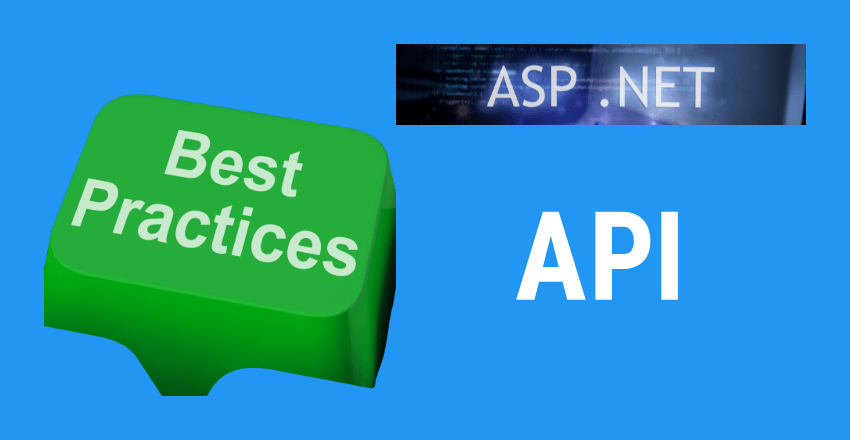 Developing web APIs using ASP.NET Core can be a complex process, requiring careful consideration of many different factors. To create efficient and scalable web APIs, it is vital to follow industry best practices and adhere to established standards.
Developing web APIs using ASP.NET Core can be a complex process, requiring careful consideration of many different factors. To create efficient and scalable web APIs, it is vital to follow industry best practices and adhere to established standards. Designing ASP.NET Core Web APIs
Designing efficient APIs is a critical aspect of ASP.NET Core Web API development. Follow these guidelines for creating well-designed APIs that meet industry standards and accommodate future changes.
Choose Appropriate HTTP Methods
HTTP methods control the actions that can be performed on resources. Use GET methods to retrieve resources, POST to create and update resources, PUT to update resources, and DELETE to delete resources.
Example:
[HttpGet] public IActionResult GetProduct(int id)
{ var product = _repository.GetProductById(id); if (product == null)
{ return NotFound(); } return Ok(product); }Design Resource URIs
Resource URIs should be both logical and intuitive. Use nouns to represent resources and avoid using verbs. Use a hierarchical structure for resources that have parent-child relationships.
Example:
[Route("api/[controller]")] [ApiController] public class ProductsController :
ControllerBase { [HttpGet("{id}")] public IActionResult GetProduct(int id)
{ var product = _repository.GetProductById(id); if (product == null)
{ return NotFound(); } return Ok(product); } }Handle Errors Effectively
Implement error handling that effectively communicates errors to clients. Use appropriate HTTP status codes, such as 400 for bad requests and 404 for not found. Return structured error messages that include error codes and descriptions.
Example:
[HttpGet("{id}")]
public IActionResult GetProduct(int id)
{
var product = _repository.GetProductById(id);
if (product == null)
{
return NotFound(new { Error = $"Product with id {id} not found" });
}
return Ok(product);
}By following these guidelines, your ASP.NET Core Web APIs will be designed correctly and will perform efficiently. When your APIs are well-designed, they’ll be more scalable, adaptable, and future-proof.
Building Efficient Web APIs
Building efficient web APIs is crucial for their successful implementation and adoption. In this section, we will explore the best practices for building efficient web APIs with ASP.NET Core. By following these practices, you can ensure that your web APIs operate smoothly, with quick response times and minimal overhead.
Implement Validation
One of the best ways to build efficient web APIs is by implementing validation. Validating incoming data can help prevent errors and reduce the likelihood of unnecessary processing. In ASP.NET Core, you can use model validation to validate incoming data. For instance, you can validate that a string is not empty or that a number is within a specific range.
Tip: Use data annotations to apply validation rules to your model properties. This will make validation more accessible and require less coding.
Use Proper Data Transfer Objects (DTOs)
Another effective way to build efficient web APIs is by using proper data transfer objects (DTOs). DTOs are objects that contain the data you want to transfer between your API and the client. They help reduce unnecessary processing and improve performance by minimizing the amount of data transferred between the API and the client.
Example: Instead of returning complex domain objects from a web API, you can create DTOs that only contain the data to be transferred, reducing the size of the data being transmitted and improving response times.
Leverage Caching Mechanisms
Another way to build efficient web APIs is by leveraging caching mechanisms. Caching mechanisms can help reduce the processing overhead involved in generating responses by storing responses in memory or on disk. In ASP.NET Core, you can use caching middleware or distributed caching to implement caching.
Tip: Use appropriate cache expiration policies based on the data’s volatility to prevent serving outdated data.
By following these best practices for building efficient web APIs, you can ensure your APIs are fast, scalable, and reliable. Keep these practices in mind to build web APIs that users will love to interact with.
Optimizing Performance in ASP.NET Core Web API Development

Efficiently optimizing performance is a crucial part of building high-quality ASP.NET Core Web APIs. Here are some best practices to ensure your APIs are running efficiently:
Use Response Compression
Response compression is a technique used to reduce the amount of data transferred between the server and client by compressing the data before it is sent. This can significantly reduce the size of the response and improve the performance of your API.
To enable response compression in your ASP.NET Core Web API, you can add the following code to your Startup.cs file:
// In ConfigureServices method
services.AddResponseCompression(options =>
{
options.Providers.Add();
options.EnableForHttps = true;
});
// In Configure method
app.UseResponseCompression();Use Efficient Serialization
Serialization is the process of converting objects into a format that can be transmitted over a network. When designing your ASP.NET Core Web API, it is important to choose a serialization format that is both efficient and easy to use.
The default serialization format for ASP.NET Core is JSON, which is a lightweight format that is easy to work with. However, if you need to optimize the performance of your API, you may want to consider using a more efficient format, such as Protocol Buffers or MessagePack.
Leverage Asynchronous Programming
Asynchronous programming is a programming technique that allows multiple tasks to be executed concurrently. By leveraging asynchronous programming, you can improve the performance of your ASP.NET Core Web API by allowing it to handle multiple requests simultaneously.
Here’s an example of how you can use asynchronous programming to make a database call in your ASP.NET Core Web API:
// In your API controller
[HttpGet]
public async Task<IActionResult> Get()
{
var result = await _dbContext.Users.ToListAsync();
return Ok(result);
}By using the async and await keywords, you can ensure that your API controller does not block while waiting for the database call to complete. This allows other requests to continue to be processed, improving the overall performance of your API.
Error Handling and Logging
When building ASP.NET Core Web APIs, effective error handling and logging are critical for maintaining the reliability and security of your application. By implementing best practices for error handling and logging, you can quickly identify and resolve issues, keep track of user activity, and ensure that your API is operating as intended.
Returning Appropriate Error Responses
One key aspect of effective error handling is returning appropriate error responses to clients. This can help clients understand what went wrong with their request and how to correct it. ASP.NET Core provides various middleware options to help create clear error messages and responses.
For instance, the UseExceptionHandler middleware can catch any unhandled exceptions and return a formatted error response. You can also customize error responses for different HTTP status codes using the UseStatusCodePages middleware.
Handling Exceptions
Another important aspect of error handling is catching and handling exceptions in your code. By handling exceptions gracefully, you can prevent your application from crashing or suffering from performance degradation. One way to catch exceptions is to use the try-catch block.
This block allows you to catch any exceptions thrown by your code and take appropriate action, such as logging the exception or returning an error response to the client.
Logging Application Events
Logging is also essential for effective error handling and debugging in ASP.NET Core Web API development. By logging application events, you can quickly diagnose errors and monitor the behavior of your API. ASP.NET Core provides a built-in logging framework that allows you to log messages within your code using various log levels, such as Debug, Information, Warning, and Error. You can also configure the logging framework to write logs to different outputs, such as a file or a database.
Example Code Snippet: Exception Handling
| Code | Description |
|---|---|
try
{
// Some code that might throw an exception
}
catch(Exception ex)
{
// Handle the exception
_logger.LogError(ex, "An error occurred");
return StatusCode(500, "Something went wrong");
} | This code shows an example of using a try-catch block to catch exceptions and handle them gracefully. The catch block logs the exception using the built-in ILogger interface and returns an appropriate error response to the client. |
Authentication and Authorization
Authentication and authorization are crucial aspects of web API security. With ASP.NET Core Web API, developers have access to a wide range of authentication and authorization mechanisms that can be implemented to secure their APIs.
Implementing Authentication
ASP.NET Core Web API allows for various authentication mechanisms, including JWT, OAuth, and OpenID Connect. JSON Web Tokens (JWT) are becoming increasingly popular due to their simplicity and scalability. JWTs are compact and self-contained, containing all necessary information about the user and their access rights in a secure manner.
Here’s an example of how to use the JWT middleware in ASP.NET Core:
services.AddAuthentication(JwtBearerDefaults.AuthenticationScheme)
.AddJwtBearer(options => {
options.TokenValidationParameters = new TokenValidationParameters
{
ValidateIssuer = true,
ValidateAudience = true,
ValidateLifetime = true,
ValidateIssuerSigningKey = true,
ValidIssuer = "yourdomain.com",
ValidAudience = "yourdomain.com",
IssuerSigningKey = "your-secret-key"
};
});Implementing Authorization
ASP.NET Core Web API also provides various authorization mechanisms, including role-based access control and policy-based authorization. Role-based access control allows developers to grant access based on the user’s role, while policy-based authorization allows for more granular control over which users have access to specific API resources.
Here’s an example of how to use policy-based authorization in ASP.NET Core:
services.AddAuthorization(options => {
options.AddPolicy("CanViewPage", policy => policy.RequireClaim("ViewPage"));
});This code creates a policy called “CanViewPage” that requires the user to have the “ViewPage” claim to access the corresponding resource.
Overall, implementing proper authentication and authorization mechanisms is crucial for securing ASP.NET Core Web APIs. Developers should carefully consider the needs of their application and choose the appropriate mechanisms to ensure optimal security.
Testing and Testability

Testing is a crucial part of ASP.NET Core Web API development. It helps to ensure that the API is functioning as expected and that any bugs or issues are caught before the API is deployed to production. Achieving testability is also important, as it enables developers to write and execute tests more efficiently.
Unit Testing
Unit testing involves testing individual units of code in isolation from the rest of the application. In ASP.NET Core Web API development, this might include testing individual controllers or services. Unit tests should be automated and run frequently to catch any issues early on. In addition, mocking frameworks like Moq can be used to simulate dependencies and make testing easier.
Integration Testing
Integration testing involves testing the interactions between different components of the application. This might include testing how the API interacts with a database or third-party service. Integration tests are typically more complex than unit tests and may require more setup and configuration to execute properly.
Tools for Testing
ASP.NET Core provides several tools to make testing easier. One such tool is xUnit, a testing framework that supports both unit and integration testing. Another tool is TestServer, which enables developers to perform end-to-end testing of the API without the need for a separate host.
Using these tools and techniques, developers can ensure that their ASP.NET Core Web API is reliable, efficient, and scalable. By investing time and effort into testing and achieving testability, developers can save time and resources in the long run, and deliver a high-quality product to their users.
Versioning and Dependency Management in ASP.NET Core Web API
Effective versioning and dependency management are critical for the success of any ASP.NET Core Web API project. Versioning allows developers to manage and deploy changes to their APIs, while dependency management helps ensure that the project has the necessary libraries and packages to run smoothly.
Implementing Versioning Strategies
One of the most critical aspects of versioning is choosing the right strategy. ASP.NET Core Web API supports several versioning strategies, including URI versioning, query string versioning, and header versioning. URI versioning involves including the version number directly in the URI of the API endpoint.
Query string versioning involves appending the version number as a query parameter to the endpoint URL. Header versioning involves including the version number in a custom header in the API request. Choose the strategy that best suits your project requirements.
Using Package Managers Like NuGet
Dependency management is an equally critical aspect of ASP.NET Core Web API development. Package managers like NuGet help developers manage their project dependencies by automatically installing and updating the necessary libraries and packages. NuGet is the most commonly used package manager in the .NET ecosystem, and it allows developers to easily search for, install, and manage dependencies.
Managing Backward Compatibility
Ensuring backward compatibility is another essential aspect of versioning in ASP.NET Core Web API development. Backward compatibility ensures that older API versions still function correctly when new versions are deployed.
This is critical for maintaining the functionality of applications built on top of the API. To maintain backward compatibility, always ensure that changes to the API are thoroughly tested and documented.
Example Code
Below is an example of URI versioning in ASP.NET Core Web API:
Endpoint for version 1:
https://example.com/api/v1/endpointEndpoint for version 2:
https://example.com/api/v2/endpointBelow is an example of using NuGet to manage dependencies in an ASP.NET Core Web API project:
Install the Microsoft.AspNetCore.Mvc package:
Install-Package Microsoft.AspNetCore.MvcBelow is an example of ensuring backward compatibility in ASP.NET Core Web API:
Documenting changes to the API:
// Added new field to response objectBy following these best practices for versioning and dependency management, developers can ensure that their ASP.NET Core Web API projects are efficient, scalable, and maintainable.
Documentation and API Design

In ASP.NET Core Web API development, proper documentation and API design are crucial for ensuring the usability and scalability of your web API. Good documentation provides clear instructions on how to use the API and can save time for both the developers and the consumers.
Consistent API design helps avoid confusion and facilitates easier maintenance of the codebase.
One best practice for documenting ASP.NET Core Web API is to use Swagger. Swagger is an open-source tool that generates interactive API documentation.
It allows developers to document their endpoints, models, and controllers, and provides a user-friendly interface for API consumers to test the API’s functionality. Swagger also supports various programming languages and frameworks, making it an excellent choice for multi-platform development teams.
Another best practice for API design is to use consistent conventions for naming and structuring endpoints. For example, using plural nouns for resource names and HTTP methods for their corresponding actions is a widely accepted convention in RESTful API design.
Utilizing a consistent URL structure and versioning strategy also helps maintain the API’s backward compatibility.
Providing clear documentation for consumer usage is equally important. This can include examples of requests and responses, explanations of error codes, and required authentication tokens. Consistency in response formats across endpoints can also aid in the ease of use of the API.
By following proper documentation and API design practices, developers can create more usable and scalable ASP.NET Core Web API projects. This ultimately saves time, increases productivity, and promotes better collaboration between developers and consumers.
Final Thoughts
Implementing best practices in ASP.NET Core Web API development is crucial for building high-performance and efficient web APIs. By following the guidelines discussed in this article, developers can ensure their APIs are designed for optimal performance, are secure and reliable, and are well-documented for consumers.
External Resources
https://learn.microsoft.com/en-us/azure/architecture/best-practices/api-design
https://restfulapi.net/rest-api-design-tutorial-with-example/
FAQ

1. How do I implement versioning in ASP.NET Core Web API?
Code Sample:
Versioning APIs is crucial for maintaining backward compatibility and evolving APIs over time. Here’s an example of URI versioning:
[ApiVersion("1.0")]
[Route("api/v{version:apiVersion}/[controller]")]
public class ProductsController : ControllerBase
{
[HttpGet]
public IActionResult Get() => Ok("Version 1.0");
}
[ApiVersion("2.0")]
[Route("api/v{version:apiVersion}/[controller]")]
public class ProductsV2Controller : ControllerBase
{
[HttpGet]
public IActionResult Get() => Ok("Version 2.0");
}
In Startup.cs, enable API versioning:
services.AddApiVersioning(options =>
{
options.DefaultApiVersion = new ApiVersion(1, 0);
options.AssumeDefaultVersionWhenUnspecified = true;
options.ReportApiVersions = true;
});
This approach uses different controllers for each version.
2. How should I handle exceptions globally in ASP.NET Core Web API?
Code Sample:
Use middleware for global exception handling. Here’s an example:
public class ExceptionMiddleware
{
private readonly RequestDelegate _next;
public ExceptionMiddleware(RequestDelegate next)
{
_next = next;
}
public async Task Invoke(HttpContext httpContext)
{
try
{
await _next(httpContext);
}
catch (Exception ex)
{
await HandleExceptionAsync(httpContext, ex);
}
}
private static Task HandleExceptionAsync(HttpContext context, Exception exception)
{
context.Response.ContentType = "application/json";
context.Response.StatusCode = StatusCodes.Status500InternalServerError;
return context.Response.WriteAsync(new ErrorDetails
{
StatusCode = context.Response.StatusCode,
Message = "An error occurred while processing your request."
}.ToString());
}
}
// Extension method for adding the middleware
public static class ExceptionMiddlewareExtensions
{
public static void ConfigureExceptionHandler(this IApplicationBuilder app)
{
app.UseMiddleware<ExceptionMiddleware>();
}
}
// Usage in Startup.cs
app.ConfigureExceptionHandler();This middleware catches exceptions, logs them, and returns a consistent error response.
3. What is the recommended way to use Dependency Injection in ASP.NET Core Web API?
Code Sample:
ASP.NET Core supports constructor injection out of the box. Here’s an example:
public interface IProductService
{
IEnumerable<Product> GetAll();
}
public class ProductService : IProductService
{
public IEnumerable<Product> GetAll() => new List<Product> { /* ... */ };
}
public class ProductsController : ControllerBase
{
private readonly IProductService _productService;
public ProductsController(IProductService productService)
{
_productService = productService;
}
[HttpGet]
public IActionResult Get()
{
var products = _productService.GetAll();
return Ok(products);
}
}
// Register in Startup.cs
services.AddScoped<IProductService, ProductService>();This approach promotes loose coupling and easier testing.
4. How can I implement logging in ASP.NET Core Web API?
Code Sample:
ASP.NET Core includes a built-in logging framework. Here’s an example of using it:
public class ProductsController : ControllerBase
{
private readonly ILogger<ProductsController> _logger;
public ProductsController(ILogger<ProductsController> logger)
{
_logger = logger;
}
[HttpGet]
public IActionResult Get()
{
_logger.LogInformation("Getting all products");
// ...
}
}
// Configuration in Startup.cs
services.AddLogging(loggingBuilder =>
{
loggingBuilder.AddConsole();
loggingBuilder.AddDebug();
});Logging should be incorporated throughout the application to track operations, errors, and custom events.
5. What’s the best way to handle configuration settings in ASP.NET Core Web API?
Code Sample:
Configuration in ASP.NET Core is typically managed through the appsettings.json file and the IOptions pattern:
{
"ProductSettings": {
"MaxProducts": 100
}
}Csharp
public class ProductSettings
{
public int MaxProducts { get; set; }
}
public class ProductsController : ControllerBase
{
private readonly ProductSettings _productSettings;
public ProductsController(IOptions<ProductSettings> options)
{
_productSettings = options.Value;
}
[HttpGet]
public IActionResult Get()
{
// Use _productSettings.MaxProducts
// ...
}
}
// In Startup.cs
services.Configure<ProductSettings>(Configuration.GetSection("ProductSettings"));
Gordon is a distinguished technical author with a wealth of experience in software development, specializing in .NET C#. With a career spanning two decades, he has made significant contributions as a programmer and scrum master at prestigious organizations like Accenture and Boston Consulting Group, where he has played a pivotal role in delivering successful projects.
Since the release of .NET C# in 2001, Gordon’s passion for this powerful programming language has been unwavering. Over the past 20 years, he has honed his expertise in .NET C# development, exploring its vast capabilities and leveraging its robust features to create cutting-edge software solutions. Gordon’s proficiency extends to various domains, including web applications, desktop software, and enterprise systems.
As a technical author, Gordon remains committed to staying at the forefront of technological advancements, continuously expanding his skills, and inspiring fellow technologists. His deep understanding of .NET C# development, coupled with his experience as a programmer and scrum master, positions him as a trusted resource for those seeking guidance and expertise. With each publication, Gordon strives to empower readers, fuel innovation, and propel the field of scientific computer science forward.







